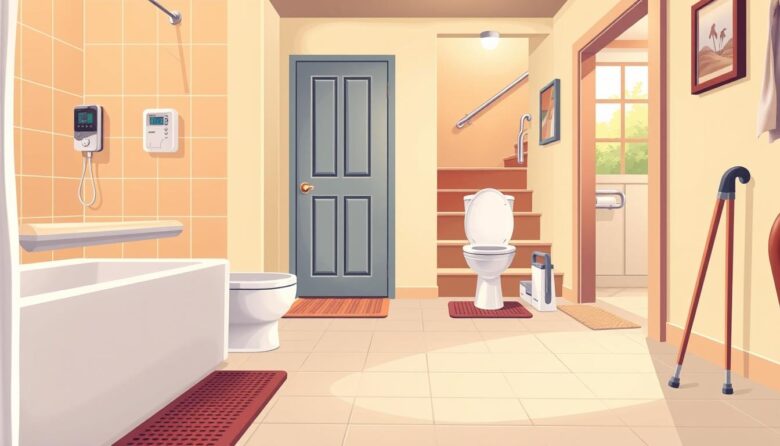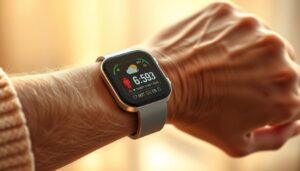Staying secure in your living space becomes more important as we age. The CDC reports over 25% of people aged 65+ experience falls annually, with serious consequences. Yet maintaining independence remains a top priority for many, with 87% preferring to age in familiar surroundings according to AARP research.
Today’s solutions combine practicality with aesthetics. Gone are the days of bulky medical equipment that screams “institutional.” Modern options discreetly blend into your decor while offering life-changing protection against common household hazards.
Creating multiple layers of security doesn’t require remodeling your entire house. Strategic upgrades in key areas can dramatically reduce risks. We’ll explore options ranging from emergency response systems to smart lighting that adapts to your routines.
Proactive planning lets you address potential issues before accidents happen. This approach not only preserves your autonomy but also prevents costly medical expenses down the road. Let’s examine the essential tools that empower safer, more confident daily living.
Key Takeaways
- Falls cause 41,000 senior deaths annually in the U.S. (CDC)
- 87% of aging Americans prioritize independent living (AARP)
- Modern protection tools blend discreetly with home decor
- Preventive measures reduce accident risks by up to 60%
- Strategic upgrades create security layers without renovations
- Quality equipment prevents long-term healthcare costs
Understanding the Importance of Home Safety for Seniors
Aging gracefully in a familiar environment requires thoughtful preparation. Your living space transforms into more than four walls—it becomes the stage where independence thrives. Older adults who choose to age in place gain priceless benefits: connection to cherished memories, control over daily routines, and community ties that nourish well-being.
Physical changes like reduced mobility or vision shifts can quietly turn ordinary spaces into challenging areas. A loose rug or dim hallway might pose unexpected risk, while bathroom surfaces could become slippery hazards. These issues demand solutions that blend seamlessly with your lifestyle rather than dominate it.
Financial protection matters just as much as physical safeguards. With Americans losing $43 billion to identity fraud last year, older adults need defenses against digital predators. Scammers often target those who value trust and personal connections.
The goal? Create layers of protection that feel natural, not clinical. Whether adding grab bars that double as towel racks or installing discreet motion sensors, modern tools preserve your comfort while addressing both immediate and long-term needs. By understanding these priorities, you can build a safety net that supports your unique way of living.
Essential home safety devices for elderly: A Comprehensive Overview
Maintaining autonomy while aging comfortably starts with smart choices in your living environment. Today’s protection tools combine practicality with subtle design, transforming what once felt clinical into elegant additions to your space.
Five core categories form the foundation of modern security solutions. Emergency response systems offer 24/7 monitoring, while bathroom modifications like slip-resistant flooring address high-risk areas. Mobility aids adapt to your movement patterns rather than disrupting them.
User-friendly features make these products accessible to everyone. Voice-controlled lighting adjusts automatically, and grab bars install without drilling holes in tiles. Many options now include self-testing capabilities that alert you to battery issues or sensor malfunctions.
Customization lets you build a system matching your unique needs. Choose from wireless alert pendants that look like jewelry or stairlifts with slim profiles. Integration capabilities allow different components to communicate, creating a network that responds to potential hazards before they escalate.
Cost-effective solutions provide lasting value through durable materials and extended warranties. Some insurance plans even offer discounts for approved modifications. With thoughtful selection, you can create layers of protection that grow with your changing requirements over time.
Medical Alert Systems: Your Lifeline for Immediate Response
Peace of mind becomes your constant companion with modern medical alert systems. These discreet tools connect you to trained professionals 24/7, whether you’re gardening in the backyard or relaxing indoors. Leading providers like Medical Guardian deliver help in under 30 seconds – faster than most 911 responses.
Smart Features for Proactive Protection
Today’s alert systems go beyond basic emergency buttons. Waterproof pendants sync with GPS for location tracking during walks. Voice-activated base units let you call for help without pressing anything. Caregiver apps keep family updated in real-time, creating a responsive support network.
Range matters when seconds count. Top-tier devices maintain connections up to 1,400 feet from their base – covering most houses and yards. Bay Alarm Medical stands out with 15-day trials, letting you test coverage in your actual living spaces.
Automatic Guardians When You Need Them Most
Fall detection technology acts like an invisible safety net. Advanced sensors analyze movement patterns to identify spills. If you can’t press the button, the device automatically alerts monitoring centers. Three-quarters of users adopt these systems after experiencing emergencies, making this feature crucial for preparedness.
Monthly costs start at $24.95 with providers like MobileHelp, offering transparent pricing without hidden fees. Whether you prefer wristbands or necklace-style wearables, these tools blend into daily life while standing ready for emergency scenarios.
Home Security and Identity Theft Protection for a Safer Environment
Protecting your independence means safeguarding both your physical space and digital presence. Modern risks demand solutions that address break-ins and cyber threats simultaneously. With $43 billion lost to identity fraud last year, creating layered defenses becomes essential for peace of mind.
Securing Your Home with Advanced Systems
Today’s security systems offer more than loud alarms. Professional monitoring services watch your property 24/7 through smart cameras and motion sensors. These systems automatically contact emergency responders if suspicious activity occurs.
Many providers bundle medical alert features with protection packages. Voice-activated controls let you arm devices or check status without complex commands. Insurance discounts often cover 15-20% of monthly fees, making comprehensive coverage surprisingly affordable.
Guarding Against Financial Risks and Identity Fraud
Cybercriminals frequently target those who value trust and community connections. Specialized services scan financial accounts, credit reports, and dark web activity for unauthorized use of your information. Real-time alerts notify you about suspicious transactions before damage escalates.
Combined plans from companies like LifeLock and ADT simplify managing both physical and digital risks. Automatic software updates ensure your defenses evolve with emerging threats. This dual approach lets you focus on enjoying daily life while experts handle potential dangers.
Bathroom Safety: Walk-In Tubs, Showers, and Grab Bars You Can Trust
Your bathroom should be a place of relaxation, not risk. With 80% of slips occurring in wet areas, smart upgrades transform this space into a secure retreat. Modern solutions combine sleek design with practical features that support confident daily routines.
Designing a Safer Bathroom Layout
Walk-in tubs from brands like Kohler eliminate dangerous step-overs with low-entry doors. Built-in seating and textured floor surfaces let you bathe comfortably while reducing fall risks. Many models include therapeutic jets for muscle relief during soaks.
Curbless shower designs create seamless access for wheelchairs or walkers. Gentle slopes channel water toward drains, preventing puddles. Pair these with adjustable showerheads placed at reachable heights for added convenience.
Today’s grab bars double as stylish accessories. Install horizontal models along the longest wall for steadying support when entering/exiting. Vertical bars near controls help maintain balance while adjusting water temperature.
Non-slip coatings or peel-and-stick mats add traction to existing floor surfaces. Professionals can anchor bars directly into wall studs, ensuring they hold up to 500 pounds. Best part? Most modifications work with your current layout – no demolition required.
Ergonomic Solutions: Shower Chairs and High-Seated Commodes for Comfort
Comfort meets practicality in spaces where daily routines unfold. Thoughtful bathroom adaptations empower confident self-care while addressing mobility challenges.
Enhancing Usability and Accessibility
Adjustable shower chairs let you bathe seated, reducing fatigue from prolonged standing. Many models feature 4-6 height settings to match your stature. Foldable armrests simplify transfers, while drainage holes prevent water buildup.
Transfer benches bridge shower edges, letting you slide safely into bathing areas. Their extended seats support up to 250 pounds, with heavy-duty options available. Non-slip feet grip surfaces securely, even when wet.
Comfort-height commodes reduce strain during daily use. These elevated seats sit 3-5 inches higher than standard models. Add-on risers offer adjustable height boosts without replacing existing fixtures.
Maintenance-friendly designs simplify cleaning routines. Removable seat cushions fit in dishwashers, while antimicrobial coatings inhibit bacteria growth. Look for contoured edges that support proper posture during use.
Safety Enhancements Throughout the Home: Handrails and Safety Rails
Transform your living spaces with thoughtful design that prioritizes confident movement. Strategic handrail placement creates invisible safety networks where you need them most. Install them along stairwells and both sides of indoor steps for steady support during climbs.
Opt for circular grips measuring 1.25-2 inches wide – the sweet spot for comfort and ADA compliance. These dimensions accommodate varying hand sizes while preventing slippage. In longer corridors, spaced rails offer resting points during walks.
Material choices adapt to your style and needs. Textured metals provide secure holds, while rubber-coated options ease arthritis discomfort. Wood finishes blend with traditional decor, proving protection doesn’t require sacrificing aesthetics.
Proper installation matters most. Anchoring rails to wall studs ensures they withstand daily use. Professionals can integrate them seamlessly into your existing layout, maintaining your space’s character while upgrading functionality.



